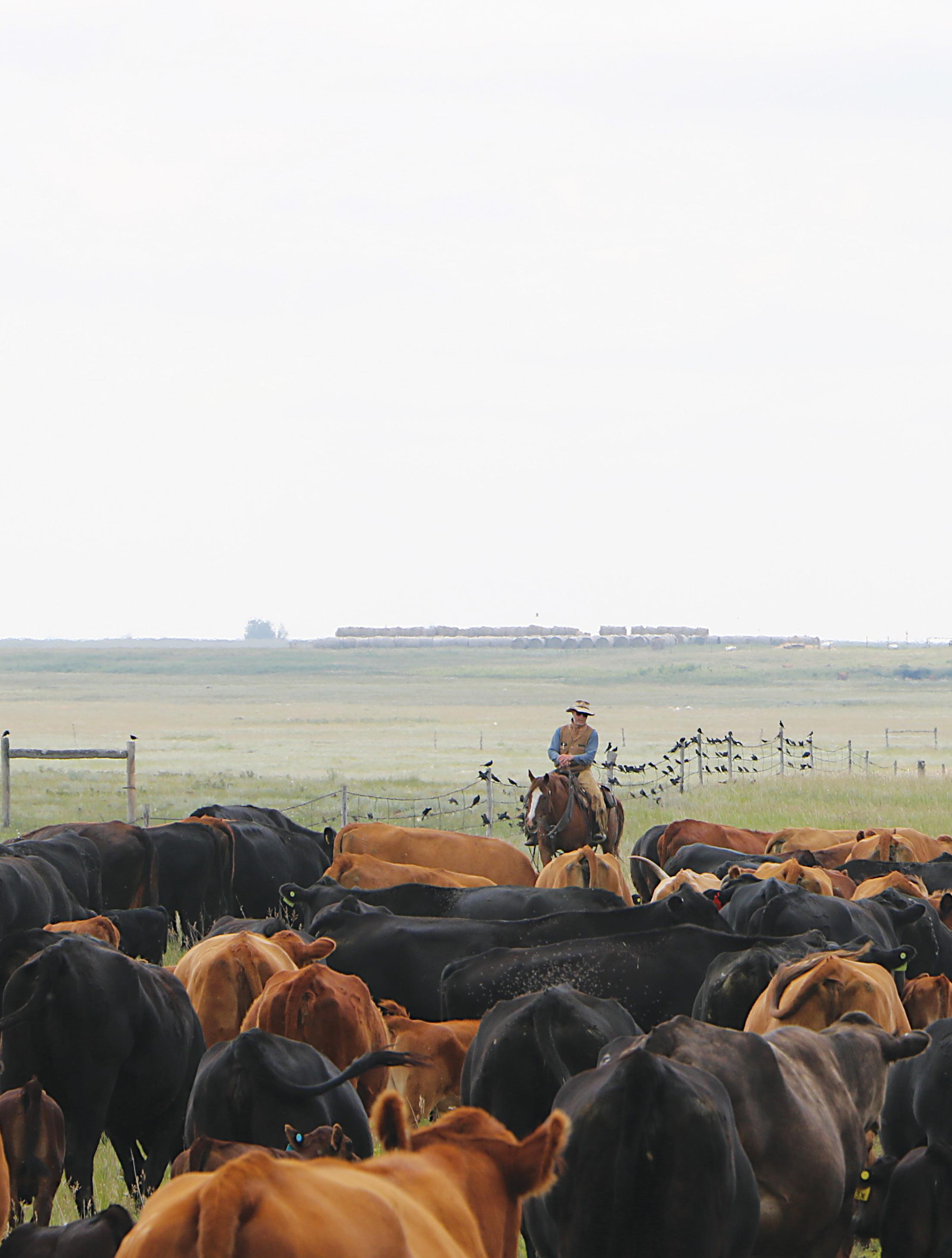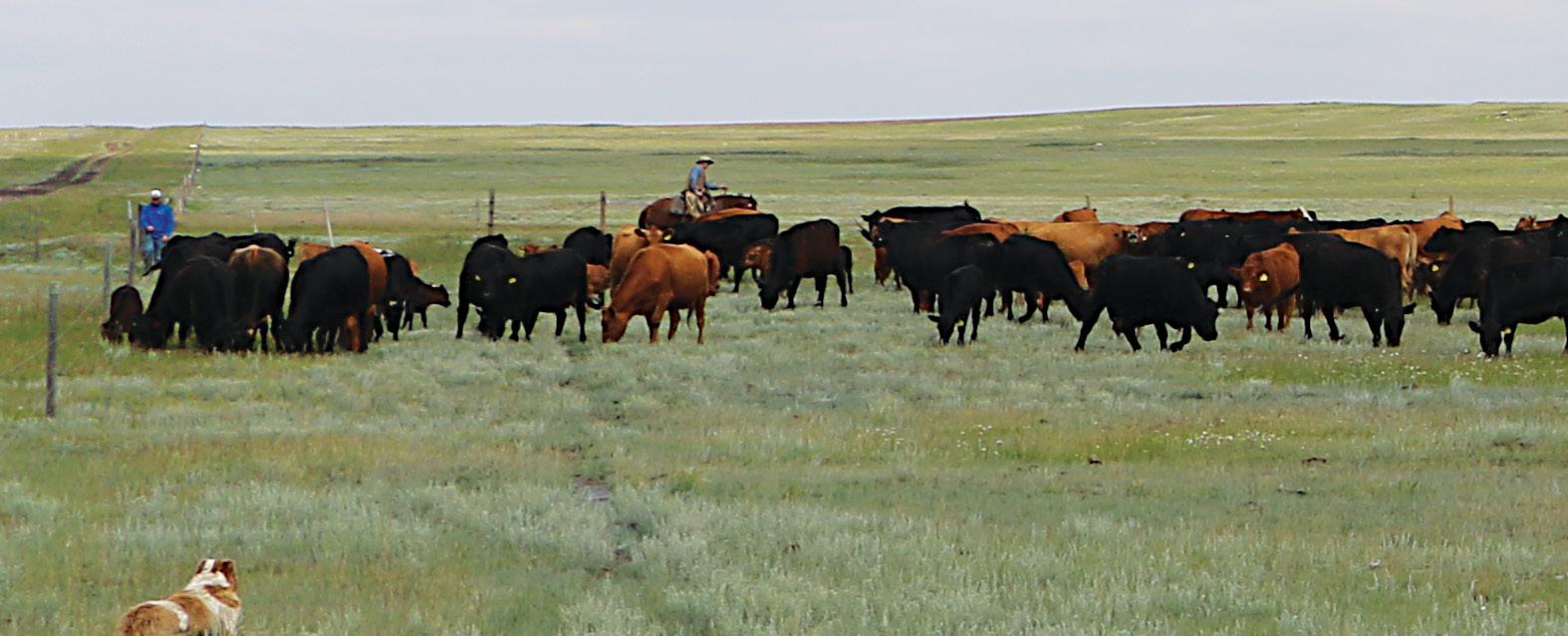
7 minute read
Moving Cow/Calf Pairs
Moving Cow/Calf Pairs
Hold Up to Stay Put
By DYLAN BIGGS
I have touched on moving cow/calf pairs in a previous article, but because of the universal challenge moving pairs presents, a more in-depth discussion is warranted.

The herd was stalled about halfway to the destination to give them a chance to pair up. Here, Dexter is letting the re-paired herd start to move out.
PHOTO COURTESY OF TK RANCH
All ranchers I have spoken to, without exception, over the last 24 years of doing livestock handling clinics have experienced the challenge of moving cow/calf pairs. Any and all of them, including myself, have had calves run back either on the way to or shortly after reaching the new pasture. All of us can relate to the frustration of doing our best to get all the cows and calves to the new pasture, and minutes after we close the gate the cows have headed off to graze, but the calves are coming back to the gate. We all know how well a fourwire or even five-wire fence or gate holds young calves that are determined to go back to find Mom — not at all. Once calves make up their mind and are on their way back, it is very difficult to convince them otherwise. And when one goes, almost guaranteed, others will follow. Once the calves have gone back, the moms too will eventually go back in search of their calves, so it is not uncommon for the job of cleaning up runbacks to take as long as the original move. It may not be the most challenging cattle handling job, but it certainly ranks right up there.
Typically, the younger the calves, the larger the herd and the farther one is going, the greater the probability of the calf losing track of Mom — especially if Mom is more interested in green grass than she is in keeping track of her calf — and the more challenging the job becomes. The age of the cow matters, too — first-calf heifers have a heck of a time keeping track of their calves compared to older cows.
A few handling tips that I learned from Bud Williams have made moving cow/calf pairs much easier on our place than it was in the past. It took me years though to actually implement what Bud shared with me. Like most folks, I didn’t feel I had the time.
Looking back, it is odd the amount of time I would spend when forced to, yet how reluctant I was to spend a fraction of that time upfront to prevent the cleanup job in the first place. Live and learn.
FIRST
Get all the cows and calves paired up before you ask the whole herd to start moving. Just get everyone up, and give them time to locate each other and get together. Time of day can help in this regard because there are times throughout a day when pretty well everyone is paired and nursing. There are also times when the calves are bedded down and the cows are off grazing. You will know you have them paired when no cows and calves are bawling for each other. If you are in a large pasture with a large herd, it may take some time to get everyone paired and ready to move, depending on the lay of the land.
SECOND
Once you are moving, do your best to let them string out. Just ask for enough movement that the front starts to go and let the front take the rest, as opposed to moving them in a big mob.
Left to their own devices, when a herd moves to water or from water back out to grass or shade, they’ll string out naturally, which is why cow trails are one cow wide. It is much easier for cows and calves to keep track of each other when they are strung out, compared to being in a mob. If the opportunity doesn’t present itself to let them string out, then so be it. When you get to the gate, being strung out will also strip a lot fewer calves, compared to a mob being put through a gate.
Early in the season when young calves haven’t been through gates before, it is important to have someone up at the gate helping squeeze those calves through the gate with Mom so that they don’t miss. Young calves won’t know what a gate is, and it can present quite an obstacle for them. If they go through the gate as a mob, lots of calves will get stripped from the cows, so the sooner one can stall the herd to give them a chance to pair up, the better.
THIRD
Always have a lead rider, and be in communication with them. The drag rider needs to pay continual attention to the amount of bawling and the number of single calves collecting at the back as the move progresses. When there gets to be quite a bunch and they start making quite a racket or for sure if you have calves starting to think about going back, have the lead rider stop the front, quit pressuring the back and let the whole herd stall and just sit, give them the opportunity to pair up.
Monitor the bawling, too. You will know a decent amount have paired up when the noise goes way down. Depending on how far you are going and the circumstances or opportunity for stalling the herd, you may want to give them a number of opportunities to pair up along the way.

Holding the cattle in the destination pasture to allow them to pair them up back.
PHOTO COURTESY TK RANCH
FOURTH/
Don’t push too hard on the back. I can’t emphasize this enough! Let the back go with the herd movement, and don’t pressure it any more than absolutely necessary. Over-pressuring unpaired young calves at the back will make them feel more insecure, and the more insecure they feel, the more they will want to run back to where they were with mom last. Block them if they go to turn back, but then let them go forward on their own. Constant over-pressure on the calves at the back is the most effective way to make them want to run back.
Calves can be taught to drive, and the more they are driven the better. They need to know that the pressure is off when they are going along.
FINALLY
Once everyone is through the last gate and into the new pasture, this is when the lead rider stalls the whole bunch one last time. The cows are not allowed to go off and graze until they have found their calves.
Don’t hold them super tight; give them some room. This will make it easier for them to find each other. The first time you do this, the cows won’t be expecting it and will object, so it may take a fair bit to keep them stalled. It is important not to push them back together tight when you do this, just tuck the ones that want to leave to graze back in. Don’t drive them back any distance — just a step or two. Once they realize they can’t just go off and graze, they will start to look for their calves. The first 10 minutes, there will be a lot of bawling and you will be tucking cows in that want to leave. Once cows and calves start to pair up and calves start nursing, the volume will start to go down. Usually for us, after about 20 to 25 minutes the cows and calves will start laying down, and only a little bawling will be heard and no cows will be asking to leave. After 30 to 35 minutes, it will be silent, and half or more of the herd will be laying down and no one will be trying to leave. This is when they are settled and you know you can leave them and that no calves will run back. Sometimes, depending on how far one has moved them, how thirsty they are and/or how motivated they are, they will stay there even after you leave.
Every time we are moving cows and calves, we are teaching them something. Worked properly as one progresses through the season, by fall calves should drive right along even if they aren’t at Mom’s side. Once a herd is taught to settle in a new pasture, it becomes a matter of habit and is easy to do. It makes moving pairs much easier and much more enjoyable.
I just wish I had learned to do this 35 years ago.

The cows and calves are paired and settled. We can leave them now and no animal will run back.
PHOTO COURTESY TK RANCH


